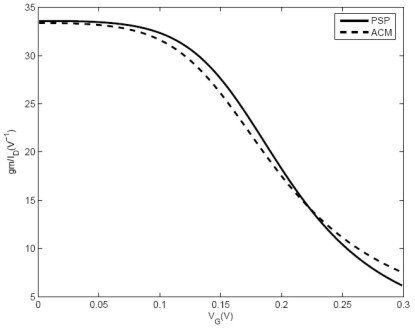The charge-based equations in [1] give
 (1) (1)
where
 (2) (2)
is the value of the transconductance-to-current ratio deep in weak inversion.
In the ACM model the threshold voltage (VT) is defined as the value of VG for which the drift and diffusion components of the drain current are equal (q'I = 1). Applying this criterion to (1) for small VDS (q'IS approximately equal to q'ID) and assuming n (slope factor) to be almost constant, allows the extraction of the threshold voltage from the gm/ID characteristic (Fig.1) by simply measuring the peak value of gm/ID and determining the gate voltage at which the value of gm/ID drops to one-half of the peak value. Applying the previously described methodology to the curve generated using the PSP model in ELDO, we find VTO=208 mV and ISQ=158 nA. To generate the transconductance-to-current ratio in Fig. 1 associated with the ACM model we embedded the values of VTO=208 mV andISQ=158 nA. The Fig.1 shows that the PSP and ACM fits very well and the transconductance-to-current characteristic should be used to determined VTO and ISQ.

Fig.1 Transconductance-to-current characteristic of an n-MOS transistor for VDS=1mV. The PSP curve was used to determine both the threshold voltage and the sheet specific current. |